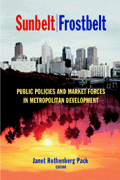Studies in this week’s Hutchins Roundup find that counties more exposed to trade liberalization with China exhibit higher mortality among white men from suicide and some other causes, hospitals do not appear to compete on quality in the market for some conditions where we would expect a lot of competition, and more.
Trade liberalization with China increased mortality from certain causes among white men
By agreeing to China’s accession to the World Trade Organization in 2000, the U.S. eliminated the threat of future tariff increases on imports from China. Justin Pierce of the Federal Reserve Board and Peter Schott of Yale find that U.S. counties more exposed to this policy change because of their industry structure had higher mortality, especially among white men, from suicide and accidental poisoning (including drug overdoses), than other counties. The authors conclude that these results are consistent with white men’s relatively high employment in manufacturing, the sector most affected by trade liberalization with China.
Competition among hospitals does not always improve quality
Theory predicts that, under a fixed-reimbursement system like Medicare, hospitals will compete by improving the quality of profitable treatments, particularly in areas where patients can exercise choice over which hospital to use. Carrie Colla, Julie Bynum, Andrea Austin, and Jonathan Skinner of Dartmouth College show that this theory has only limited empirical success. On the one hand, consistent with the theory, competition is associated with higher quality in heart attack treatment, which is profitable, and lower quality in dementia treatment, which is unprofitable. On the other hand, contrary to the theory, they find no association between competition and the quality of hip and knee replacements—profitable treatments for which patients can exercise choice over hospitals.
The Limits of Traditional Monetary Policy
Joseph Stiglitz of Columbia argues that monetary policy was relatively ineffective in restoring robust economic growth after the Great Recession not because the Federal Reserve couldn’t cut rates below zero, but because of the availability of credit, the terms at which it was available, and the uses to which it was put. He points out that an increase in credit availability may not lead to more spending on domestically produced goods, but instead to spending on land and other fixed assets or spending abroad rather than at home. He also concludes that monetary policy is more distortionary than often assumed, and proposes alternative ways to direct credit to foster responsible lending and financial stability.
Chart of the week: Capacity utilization remains low by historical standards

Quote of the week: I often hear that there are too many voices offering too much diversity of views about the likely path of policy–the cacophony problem,” says Fed governor Jerome Powell.
“Reserve Bank Presidents and Governors are expected to publicly discuss their views on the economy and policy. Indeed, our policy on the external communications of FOMC participants states that ‘the Committee’s public accountability is strengthened by open discussion of Committee participants’ views about the economic outlook as well as their judgments about the appropriate course of monetary policy.’ Central banking often comes across as obscure and complicated, and we try to help the public understand what we do. But there is more to it than that… In my view, the public expression of our diverse views helps sustain public support for the Federal Reserve as a public institution. Those members of the public who disagree with our policy should know that their concerns are given voice in our deliberations. But there is a tradeoff here that needs to be managed: On the one hand, the effectiveness of policy is thought to depend on the public’s understanding of the Committee’s consensus. On the other hand, the expression of diverse views may sometimes make it difficult for the public to see that consensus.”
The Brookings Institution is committed to quality, independence, and impact.
We are supported by a diverse array of funders. In line with our values and policies, each Brookings publication represents the sole views of its author(s).






Commentary
Hutchins Roundup: Trade liberalization, hospital competition, and more
Thursday, December 1, 2016